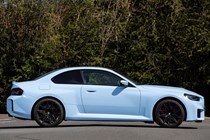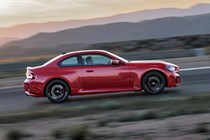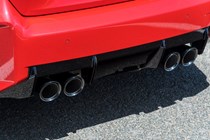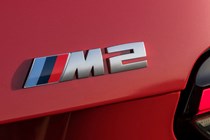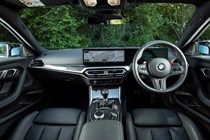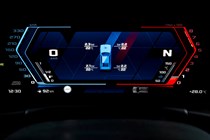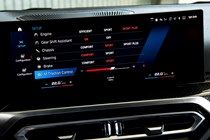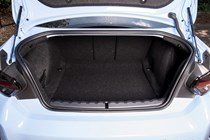
BMW 2-Series M2 review
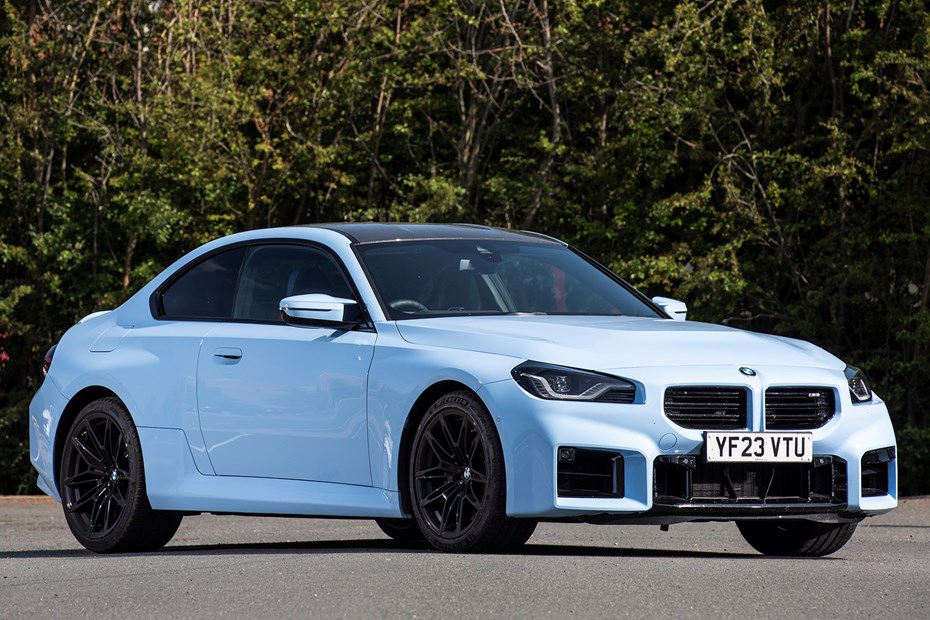
At a glance
| Price new | £68,795 - £92,475 |
|---|---|
| Used prices | £40,796 - £56,088 |
| Road tax cost | £195 - £620 |
| Insurance group | 40 - 45 |
Get an insurance quote with

|
|
| Fuel economy | 28 - 29.1 mpg |
| Miles per pound | 4.1 - 4.3 |
| Number of doors | 2 |
| View full specs for a specific version | |
Available fuel types
Petrol
Pros & cons
- Engaging and exciting to drive
- Comfortable and quiet when cruising
- Modern and high-quality feel
- Expensive compared with rivals
- Bigger and heavier than its predecessor
- Mature feel may not appeal to all
Overview
The BMW M2 is now in its second generation. When the first-generation model was launched in 2016, it was designed to be the M division’s, smallest, most accessible performance car. But, following the trend that barely any manufacturer has managed to buck, this G87-generation M2 is longer, wider, heavier and more expensive than its predecessor.
However, it’s also a lot more powerful and considerably quicker in a straight line. Consequently, there’s a lot stacked in its favour when it comes to repeating the success of the previous M2, not least because it retains a lot of the qualities that made the old car such a gem.
This M2 is still rear-wheel drive (where other M performance cars such as the M3 sports saloon have switched to four-wheel drive), it’s still available with a manual gearbox, and it’s powered by a mighty twin-turbocharged 3.0-litre straight-six engine.
Yes, the M2 might now weigh close to 1,800kg, but it compensates that by producing 460hp. That’s almost 100hp more than you got in the previous BMW M2 Coupe. There’s loads of technology on hand, too, including dual-zone climate control, a head-up display, M Drift Analyser and M Laptimer, and options such as M Carbon bucket seats.
Sure, the Lego-esque styling might not be to all tastes, but the M2 has plenty to draw attention to it otherwise, especially when compared to its four-cylinder alternatives. And while it is unquestionably expensive, it makes a very good sales pitch.
Look past the negatives such as its increased weight, and you’ll find the new M2 is quicker, more enjoyable and more refined than its predecessor. It might not have quite the same rawness or compact hot-rod vibe to it as before but, for some, that more grown-up character will only increase its appeal.
What’s it like inside?
You pay a steep premium for the BMW M2. Prices start from around £68,000, which makes it around £3,000 pricier than the equivalent Porsche Cayman or a whopping £10,000 more expensive than the Parkers award-winning Alpine A110. It’s also worth noting that the manual (which is the one you want) is around £1,200 more expensive than the automatic.
Fortunately, BMW can justify at least some of that extra cash with the M2’s cabin, because it’s every bit as well-equipped as the company’s larger executive saloons. Standard equipment includes heated seats, automatic air conditioning and an ambient interior lighting system.

You also get BMW’s enormous Curved Display infotainment system, which connects a digital gauge cluster and a central infotainment under one giant piece of concave glass. It’s an accomplished system with a logical menu layout and crystal clear graphics.
Plus, you can control the latter screen using BMW’s iDrive dial on the car’s centre console. That means you spend less time pawing at the touchscreen and more time focusing on the road, which is welcome when you have 460hp under your right foot.
The cabin of the currentM2 is also slightly wider and longer than its predecessor, and the interior feels much bigger than the marginal gains BMW tells us it’s made. You still sit low in the car, too, which makes it easy to feel what it’s doing beneath you.
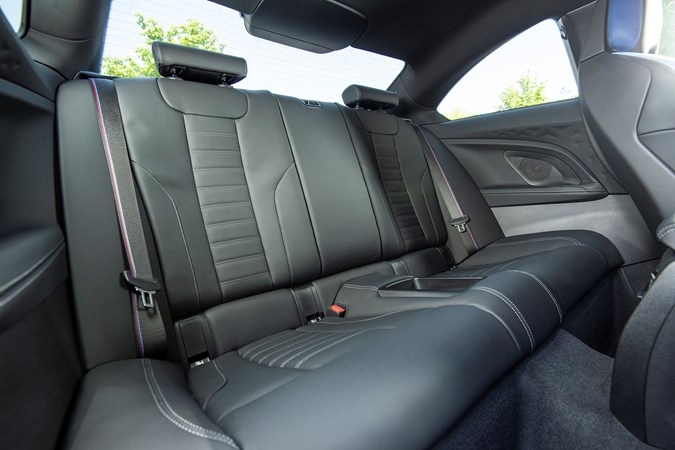
In terms of storage, the M2 has a useful 390-litre boot, which is on a par with many conventional three- and five-door hatchbacks. That means it’s easy to use it as your only transport for a weekend away. We’ve tried and we managed perfectly well.
Just bear in mind that, because it isn’t a hatchback, there are big hinges under the boot lid which makes squeezing large, solid items (such as hard-shelled suitcases or boxes) into the space rather tricky. You can fold the rear seats down, though, which is just as well because they’re basically useless if you have a tall driver and passenger up front. They split in 40:20:40 configuration.
Comfort
The performance-focused M2 has M Sport seats with big, supportive bolsters. They look a little too aggressive to be comfortable on first inspection by, gratifyingly, they’re quite soft and forgiving. They give your torso plenty of space to move, too, holding you in a snug rather than clenching fashion.
Be warned, though – if you plan to take the M2 on a very long drive, you might struggle with the central divide in base of the car’s optional carbon-backed seat. They hold your legs in one position, which we found can give you cramps after a few hours at the wheel.

You can alleviate some of the pains by fiddling with the seats’ generous adjustment settings. We found that, by tilting the seat forwards and backwards, you can move the pressure between your calves and your thighs, which helps combat muscle fatigue.
Once you’ve got to grips with your seating position, you find the current M2 is much more comfortable on the move. The chop and harshness of the old model is gone, with the new M2’s adaptive suspension being quieter, smoother and more forgiving in Comfort mode.
Safety
Euro NCAP hasn’t crash tested the BMW M2. However, the regular 2 Series Coupe on which it’s based has been assessed by the safety body – and it scored four stars in its crash tests back in 2022.
Euro NCAP’s report was generally complimentary. Its main criticism was the car’s lack of a centre airbag, to reduce occupant-to-occupant injuries, and the absence of a system that could prevent secondary impacts after a crash. Post-collision braking systems, sometimes called multi-collision braking, are standard on alternatives such as the Porsche Cayman.
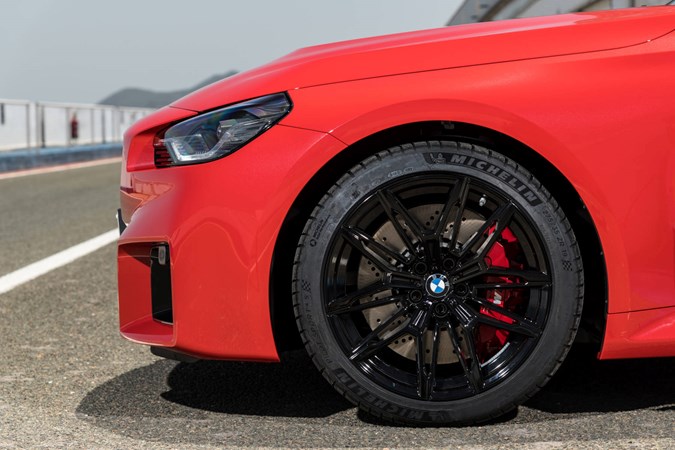
The M2 shares the same basic level of safety equipment as the standard 2 Series Coupe so, if you’re looking for an exceptionally safe and compact high-performance coupe, you may wish to look elsewhere.
Despite this, the M2 comes with lots of other driver assistance technology as standard, including autonomous emergency braking, lane-keeping assist, traffic sign recognition, cruise control, a speed limiter and automatic LED headlights. You also get front and rear parking sensors and a rear-view camera.
What’s it like to drive?
That depends on what driving mode you select. The M2 is surprisingly approachable in normal mode – its engine is muted, its throttle calibration is dulled (which makes the car feel far less bitey) and its dampers are softened right off.
Plus, BMW has given the new M2 a more thorough polishing than the old one. Road and wind noise is better controlled, and the car’s chassis is a lot more forgiving than before. That means you can enjoy it more often – and take it on longer journeys.
In fact, we toured the M2 all around southern England, and the only issue we found with its comfort was its bucket seats. They hold you in place a little too well, which is ideal for the racetrack but a little constraining on a motorway drive.
These minor quibbles pale into insignificance when you switch the M2 to M mode, though. It almost feels like you’ve given the car electroacupuncture – its chassis tenses up, its steering weight is dialled up to eleven, the valves in the exhaust are thrust wide open and the throttle response becomes sharper than a butcher’s cleaver.
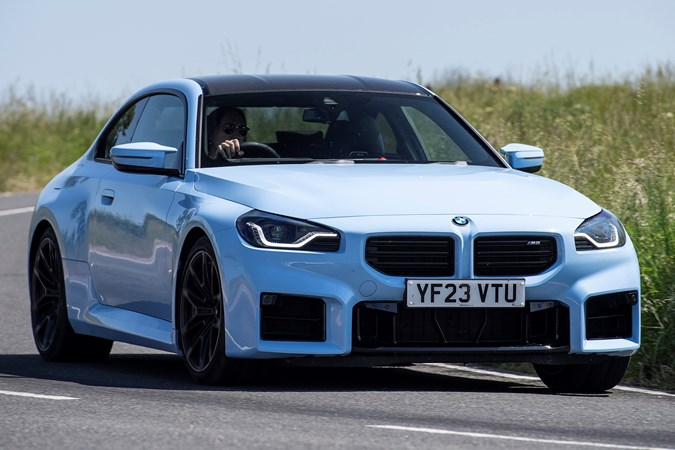
It’s viciously fast in a straight line – and it delivers its performance in a deliciously old-school fashion. The engine grumbles and groans below 2,000rpm as chokes from the lack of boost passing into its cylinders. The turbos don’t wake up until around 4,000rpm, at which point they cram all the air they can into the engine’s gullet, and you get hurled at the horizon whether you like it or not.
The M2’s straight-line performance is difficult to put into words, so we’ll illustrate our point with some statistics. It has 460hp, 550Nm of torque (pulling power), a 0–62mph time of 4.3 seconds and a limited top speed of 155mph. However, if you stump up some extra cash for BMW’s M Driver’s pack, that last figure climbs to 180mph. So yeah, it’s plenty fast enough.
We also can’t begin to express how joyful it is to drive such a powerful sports coupe when it’s fitted with a manual gearbox. It makes the experience so much more engaging and, because its engine works best on full boost, the M2 constantly begs you to wring its neck between shifts. In fact, we think the engine’s 7,200rpm redline is a little too conservative – it felt like it had at least another 1,000rpm to give.
The M2’s gearbox is far from being the best manual we’ve experienced, though. It isn’t anywhere near as mechanically precise as the gearbox you got in the old Toyota GR86, for example. That means you won’t hit every shift perfectly – but the clutch is meaty and positive, so the car will reward those who take the time to master its quirks.
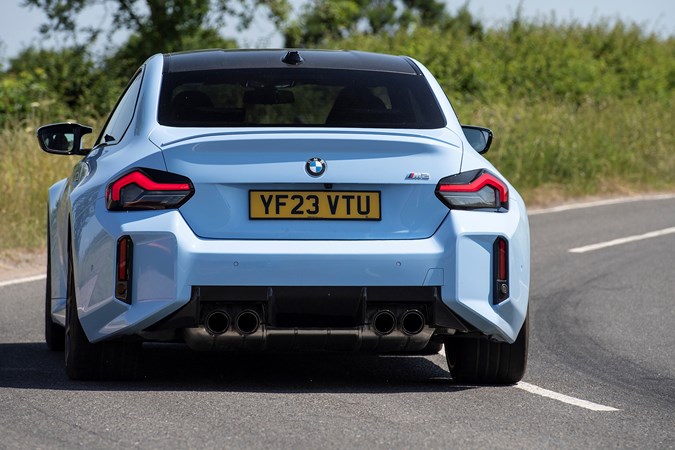
It’s a slightly different story when you a reach a corner, though. The new M2 is bigger and heavier than the car it replaced. It weighs well over 1,800kg with a driver on board, which means it can feel like a bit of brute the first time you thread it down a narrow road. We’d be wrong to call it unwieldy, though. Once you’re accustomed to the M2’s size and weight, it’s a very easy to go incredibly fast in.
The steering is pure and direct, and there’s loads of grip to be found even when you’re pushing hard. It’s especially impressive under power – you can feel the rear end squat down and claw into the road. Plus, you can make the M2 feel even less intimidating by putting its adaptive dampers in comfort mode and allowing them to manage the rise and fall of the chassis rather than just locking it down solid as they do in M mode.
To us, the new M2 feels lie a nimbler and more entertaining M3, and it doesn’t feel as heavy as the numbers suggest. Altogether, the result is a car that’s more enjoyable to drive than the previous one, and a car that’s more polished and refined.
Ownership costs and maintenance
BMW says the M2 can achieve up to 28mpg on the WLTP combined cycle. However, we managed to beat that figure on a gentle motorway cruise, averaging more than 32mpg. Alternatives such as the entry-level Porsche Cayman and Alpine A110 can do much better than that, partly because their engines have two fewer cylinders.
The BMW also has a 52-litre fuel tank, which is smaller than some of its rivals, which will further increase the frequency of your petrol station visits. It feels rather silly to report on these facts, though, because anyone who cares about fuel economy probably shouldn’t be shopping for a 460hp, six-cylinder sports coupe.
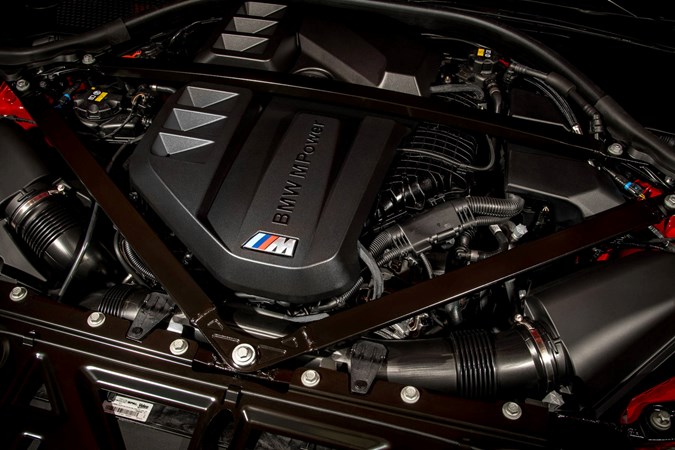
BMW does make it make it very convenient to own an M2 with its Service Inclusive package. You simply pay a lump sum up front and BMW will provide all the required servicing up to your fifth year of ownership or 62,000 miles, whichever comes first. And, in keeping with the M2’s more accessible brief, its fixed-price servicing is the least expensive of all the BMW M cars.
In terms of warranty, you get a three-year unlimited mileage package. However, if you plan on owning your M2 long-term, we recommend opting for an extended warranty. BMW doesn’t have a great reputation for reliability and any complicated problems could prove expensive to fix, so warranty extensions are well worth investing in.
What models and trims are available?
There’s only one version of the M2 on the market. However, you can customise your car with seven paint finishes, four alloy wheel designs, four upholstery options, red or blue brake calipers, and – of course – a six-speed manual or eight-speed automatic gearbox. Only one interior trim option is available, which is carbon fibre.
Standard equipment is extensive, as you’d hope given the cost of the BMW M2, with factory-fit features including a Harman/Kardon surround-sound audio system, heated electric front sports seats, adaptive LED headlights, an active M Sport differential, cruise control and a full-colour head-up display system.
Naturally, there are also some upgrade packages to further expand the M2’s kit list. The first is BMW’s Comfort Package, which adds features such as keyless entry, a heated steering wheel and a wireless charging tray in the front of the centre console.
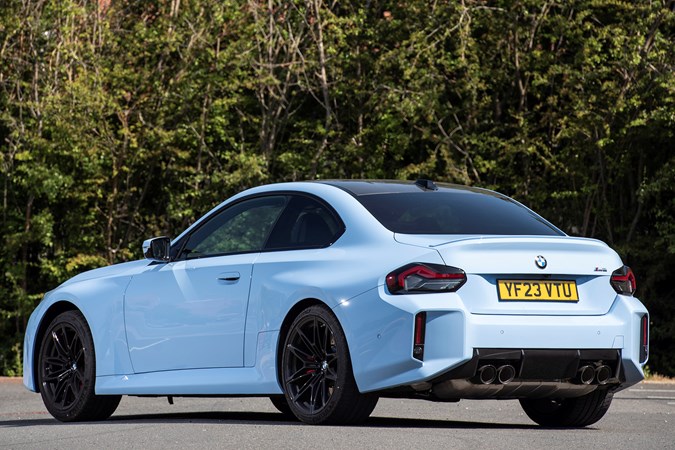
BMW’s M Driver’s Pack bumps up the M2’s speed limiter from 155mph to 180mph, while the M Race Track Package bolts on a carbon fibre roof and carbon-backed bucket seats. The race pack also includes the increased speed limiter.
Finally, customers can upgrade their cars further with a selection of BMW M Performance parts. These include lightweight forged alloy wjeels, a titanium rear exhast assembly and additional carbon fibre exterior parts.
Now read our verdict to see if we recommend the BMW M2.



